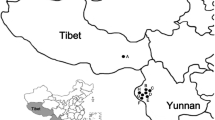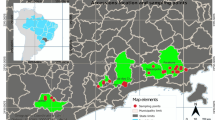Abstract
Citrus depressa Hayata is an indigenous mandarin species on the Ryukyu Islands located in the subtropical region of Japan. We deduced its phylogenetic relationships by evaluating accessions grown on various Ryukyu Islands via cleaved amplified polymorphic sequence analysis of cpDNA and sequence-related amplified polymorphism (SRAP). The cpDNA results indicated that C. depressa could be classified into two types. SRAP revealed patterns of diversity within C. depressa consistent with our cpDNA results. These results indicate that maternal origin may influence or is correlated with the constitution of the nuclear genome of C. depressa. Another Japanese mandarin species, Citrus tachibana (Makino) Tanaka was distinguished from C. depressa by SRAP markers. Moreover, both C. depressa and C. tachibana could be distinguished from other Citrus species. Our results suggest that Japanese mandarin possesses a characteristic genome with the genus Citrus.



Similar content being viewed by others
References
Asadi Abkenar A, Isshiki S, Tashiro Y (2004) Phylogenic relationships in the “true citrus fruit trees” revealed by PCR-RFLP analysis of cpDNA. Sci Hortic 102:233–242
Arnold M, Bucker LCM, Robinson JJ (1991) Pollen-mediated introgression and hybrid speciation in Louisiana irises. Proc Natl Acad Sci (USA) 88:1398–1402
Barkley NA, Roose ML, Krueger RR, Federici CT (2006) Assessing genetic diversity and population structure in a citrus germplasm collection utilizing simple sequence repeat markers (SSRs). Theor Appl Genet 112:1519–1531
Bayer RJ, Mabberley DJ, Morton C, Miller CH, Sharma IK, Pfeil BE, Rich S, Hitchcock R, Sykes S (2009) A molecular phylogeny of the orange subfamily (Rutaceae: Aurantioideae) using nine cpDNA sequences. Am J Bot 96:668–685
Dice LR (1945) Measures of the amount of ecologic association between species. Ecology 26:297–302
Dumolin-Lapegue S, Pemonge MH, Petit RJ (1997) An enlarged set of consensus primers for the study of organelle DNA in plants. Mol Ecol 6:393–397
Federici CT, Fang DQ, Scora RW, Roose ML (1998) Phylogenetic relationships within the genus Citrus (Rutaceae) and related genera as revealed by RFLP and RAPD analysis. Theor Appl Genet 96:812–822
Froelicher Y, Mouhaya W, Bassene J-B, Costantino G, Kamiri M, Luro F, Morillon R, Ollitraultet P (2011) New universal mitochondrial PCR markers reveal new information on maternal citrus phylogeny. Tree Genet Genomes 7:49–61
Hirai M, Kozaki I, Kajiura I (1986) Isozyme analysis and phylogenic relationship of citrus. Jpn J Breed 36:377–389
Hirai M, Mitsue S, Kita K, Kajiura I (1990) A survey and isozyme analysis of wild mandarin, tachibana (Citrus tachibana (Mak.) Tanaka) growing in Japan. J Jpn Soc Hortic Sci 59:1–7
Hodgeson RW (1967) Horticultural varieties of citrus. In: Reuther W, Webber HJ, Batchelor LD (eds) The citrus industry, vol 1. University of California, Berkeley, pp 431–588
Inafuku-Teramoto S, Yamamoto M, Kinjo H, Kitajima A, Wada K, Kawamitsu Y (2010) Local citrus genetic resources and their polymethoxyflavones content in northern part of Okinawa Island. Hortic Res (Jpn) 9:263–271
Kinjo H (2007) Acid citrus “Shiikuwasha” in Ryukyu island. Stud Citrol 17:137–148
Kita M, Yamamoto M, Inamori H, Sakaue H, Sekita T, Tahara A, Minoru H (2013) Exploration for citrus genetic resources in Amami Archipelago in Kagoshima Prefecture, Japan. Annu Rep Explor Introd Plant Genet Resour 29:107–117
Li G, Quiros CF (2001) Sequence-related amplified polymorphism (SRAP), a new marker system based on a simple PCR reaction: its application to mapping and gene tagging in Brassica. Theor Appl Genet 103:455–461
Mabberley DJ (1997) A classification for edible Citrus (Rutaceae). Telopea 7:167–172
Nagano Y, Inafuku-Teramoto S, Hashimoto M, Mimura T, Matsumoto R, Yamamoto M (2014) Characterization of chloroplast matK sequences of Citrus tachibana and Citrus depressa, two indigenous species in Japan. Adv Hortic Sci 28:95–99
Nicolosi E, Deng ZN, Gentile A, La Malfa S, Continella G, Tribulato E (2000) Citrus phylogeny and genetic origin of important species as investigated by molecular markers. Theor Appl Genet 100:1155–1166
Swingle WT, Reece PC (1967) The botany of citrus and its wild relatives. In: Reuther W, Webber HJ, Batchelor LD (eds) The citrus industry, vol 1. University of California, Berkeley, pp 190–430
Taberlet P, Gielly L, Pautou G, Bouvet J (1991) Universal primers for amplification of three non-coding regions of chloroplast DNA. Plant Mol Biol 17:1105–1109
Tamura K, Dudley J, Nei M, Kumar S (2007) MEGA4: molecular evolutionary genetics analysis (MEGA) software version 4.0. Mol Biol Evol 24:1596–1599
Tanaka T (1926) Wild Citri of the Japanese territories. Bul Sci Fak Kjusu Imp Univ 2:51–58
Tanaka T (1969) Misunderstanding with regards citrus classification and nomenclature. Bull Univ Osaka Prefect B21:139–145
Tanaka T (1977) Fundamental discussion of citrus classification. Stud Citrol 14:1–5
Tanaka Y (1948) An iconography of Japanese citrus fruits, vol 2. Yokendo, Tokyo (in Japanese)
Ueno I, Iwamasa M, Nishiura M (1967) Embryo number of various varieties of citrus and its relatives. Bull Hortic Res Sta Jpn B7:11–21
Urasaki N, Yoshida K, Uehara T, Inoue H, Onda S, Kinjyo H, Kawano S (2005) Single nucleotide polymorphism in shiikuwasha (Citrus depressa Hayata) chloroplast DNA, trnL-trnF. Jpn J Trop Agric 49:246–251
Uzun A, Yesiloglu T, Aka-Kacar Y, Tuzcu O, Gulsen O (2009) Genetic diversity and relationships within Citrus and related genera based on sequence related amplified polymorphism markers (SRAPs). Sci Hortic 121:306–312
Yamamoto M, Tominaga S (2003) High chromosomal variability of mandarin (Citrus spp.) revealed by CMA banding. Euphytica 129:267–274
Yamamoto M, Matsuo Y, Kuniga T, Matsumoto R, Yamada Y (1998) Isozyme and RAPD analyses of shiikuwashas (Citrus depressa Hayata). Bull Natl Inst Fruit Tree Sci 30/31:39–51
Yamamoto M, Kubo T, Tominaga S (2006a) Self- and cross-incompatibility of various Citrus accessions. J Jpn Soc Hortic Sci 75:372–378
Yamamoto M, Matsushima K, Ijichi T, Uechi Y, Kawaguchi S, Nakano H, Nomura T, Tanimura O, Kubo T, Tominaga S (2006b) Exploration and preservation of local citrus germplasms in the Amami archipelago. Bull Exp Farm Fac Agric Kagoshima Univ 29:5–11
Yamamoto M, Kubo T, Tominaga S (2008) Exploration of local citrus Citrus depressa Hayata germplasms in Okinoerabu Island. Bull Exp Farm Fac Agric Kagoshima Univ 30:15–17
Yamamoto M, Fukuda M, Koga T, Kubo T, Tominaga S (2010) Examination of the origin of Keraji (Citrus keraji), local citrus of Kikaijima Island, Kagoshima Prefecture. Hortic Res (Jpn) 9:7–12
Yamamoto M, Tsuchimochi Y, Ninomiya T, Koga T, Kitajima A, Yamasaki A, Inafuku-Teramoto S, Yang X, Yang X, Zhong G, Nasir N, Kubo T, Tominaga S (2013) Diversity of chloroplast DNA in various mandarins (Citrus spp.) and other citrus demonstrated by CAPS analysis. J Jpn Soc Hortic Sci 82:106–113
Author information
Authors and Affiliations
Corresponding author
Rights and permissions
About this article
Cite this article
Yamamoto, M., Takakura, A., Tanabe, A. et al. Diversity of Citrus depressa Hayata (Shiikuwasha) revealed by DNA analysis. Genet Resour Crop Evol 64, 805–814 (2017). https://doi.org/10.1007/s10722-016-0403-2
Received:
Accepted:
Published:
Issue Date:
DOI: https://doi.org/10.1007/s10722-016-0403-2




